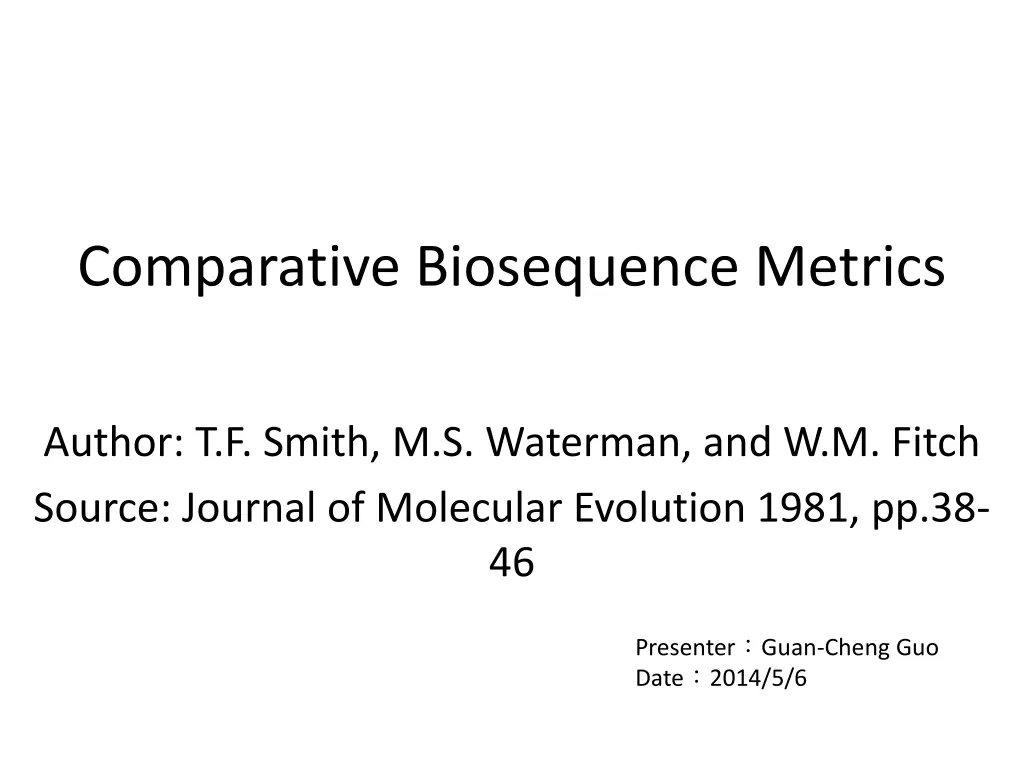
Comparative Biosequence Metrics: Needleman-Wunsch vs Sellers Algorithm Comparison
Exploring the equivalence of Needleman-Wunsch and Sellers algorithms in biosequence alignment reveals how they produce similar results through different approaches. The utility of these algorithms extends to various sequence types beyond genetics, illustrated with examples and key metric analyses.
Download Presentation

Please find below an Image/Link to download the presentation.
The content on the website is provided AS IS for your information and personal use only. It may not be sold, licensed, or shared on other websites without obtaining consent from the author. If you encounter any issues during the download, it is possible that the publisher has removed the file from their server.
You are allowed to download the files provided on this website for personal or commercial use, subject to the condition that they are used lawfully. All files are the property of their respective owners.
The content on the website is provided AS IS for your information and personal use only. It may not be sold, licensed, or shared on other websites without obtaining consent from the author.
E N D
Presentation Transcript
Comparative Biosequence Metrics Author: T.F. Smith, M.S. Waterman, and W.M. Fitch Source: Journal of Molecular Evolution 1981, pp.38- 46 Presenter Guan-Cheng Guo Date 2014/5/6
Abstract The sequence alignment algorithms of Needleman and Wunsch (1970) and Sellers (1974) are compared. Although the former maximizes similarity and the latter minimizes differences, the two procedures are proven to be equivalent. The equivalence relations necessary for each procedure to give the same result are: 1, the weight assigned to gaps in the Sellers algorithm exceed that in the Needleman-Wunsch algorithm by exactly half the length of the gap times the maximum match value; and 2, for any pair of aligned elements, the degree of similarity assigned by the Needleman- Wunsch algorithm plus the degree of dissimilarity assigned by the Sellers algorithm equal a constant. The utility of the algorithms is independent of the nature of the elements in the sequence and could include anything from geological sequences to the amino acid sequences of proteins. Examples are provided using known nucleotide sequences, one of which shows two sequences to be analogous rather than homologous.
NeedlemanWunsch algorithm vs. Sellers algorithm Major differences between the Needleman- Wunsch and the Sellers algorithms: Needleman-Wunsch algorithm results in alignments having a maximum similarity measure. Sellers algorithm results in alignments having a minimal distance or metric measure of dissimilarity.
Analysis Consider two sequences A and B of length n and m respectively, where A= a1 a2 a3 ... an and B = b1 b2 b3 ... bm. Example:
Analysis Let be the number of pairs containing identical or matched elements, be the number of pairs containing non-identical or mismatched elements (excluding the null element) and kbe the number of gaps of length k. Total element: n + m = 2( + ) + kk k (1)
Analysis Needleman-Wunsch algorithm: similarity measure, s s = maximum[ kwk k] wkis the weight or penalty (2) The quantity, s, is a measure of maximum similarity minus gap penalties
Analysis The Sellers algorithm: distance measure, d d = minimum[ + kw k k] (3) Here w kis a gap weight analogous to wkand d is a proper distance obeying the required metric properties.
Analysis An equivalence between the Needleman-Wunsch and the Sellers algorithms is established via equation (1). Using equation (1) the maximization given in (2) can be rewritten as: s = maximum{n+m 2 s =n+m 2 The maximum of a quantity can be replaced by the negative of the minimum of its negative to give s =n+m 2 1 2 (k + 2wk) k} (4a) + maximum{ (k (4b) 2+wk) k} minimum{ + (k (4c) 2+wk) k}
Analysis The alignments obtained for the Needleman- Wunsch maximum similarity, s, are identical to those obtained from the minimization of the quantity + (k 2+wk) k This is identical to the quantity minimized by the Sellers algorithm if the Sellers gap weight w kis equated to the Needleman-Wunsch gap weight plus half the gap length w k= k 2+wk (5)
Analysis The logic leading to relationship (5) can be generalized to include matches and mismatches of varying degree. Equation 1 can be written as n + m = 2 i i+ kk k iis the number of matches of degree i in an alignment.
Analysis Consider each pair of associated elements to match , but to various degrees, i. Let a perfect match have a maximum similarity of maxand others a lesser degree down to a complete mismatch having a similarity of zero. 0 i max
Analysis Show the equivalent of Needleman-Wunsch similarity measure to the Sellers metric. Assign a weight ito each match of degree i, then the similarity measure becomes s = max{ i i wk k} (6a) A weight or distance jcan be assigned measuring the degree of mismatch in the Sellers distance for any degree of match. d = min{ j i+ w k k} (6b)
Analysis jis just a distance measure between paired elements in the alignment. Let the relationship between i and j be i= max j It will yield an equivalence between the optimal alignments produced by the two algorithms provided that the gap weights are related, as before, by w k= wk+k max (7) 2
Analysis conclusion Consider the case where the sequence lengths are equal (m = n) and wk 0 (hence w k k max The minimum and maximum values of s are 0 and n max. The corresponding values of d are 0 and n max. If the weights have been chosen to make the algorithms equivalent, they have the same bounds and for any given alignment, s + d = n max. If the sequences are not of the same length(m>n), the lower bound of s is - (m - n) wm n ). 2
